Native elements: Gold
 Diagnostic card.
Diagnostic card.
Native gold in quartz, found in the Brusson mine
Au
Cubic amount of cubic zirconia
Hardness 2,5-3
Specific weight 15.5-19.3
Cleavage is absent
Cracked hook
Color yellow golden yellow yellow-brass
Color in powder yellow
Glitter metal
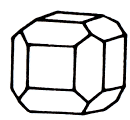
 Gold. The gloss is metallic, opaque. The color is golden yellow. The dash is golden yellow. The fracture is hooked. Kovko. Cleavage is absent. It is formed in quartz veins (root), accumulates in placers (placer). Crystals (cubic syngony) are rare.
Gold. The gloss is metallic, opaque. The color is golden yellow. The dash is golden yellow. The fracture is hooked. Kovko. Cleavage is absent. It is formed in quartz veins (root), accumulates in placers (placer). Crystals (cubic syngony) are rare.
More often lamellar or elongated in the form of wire individuals, dendrites, nuggets. Used for making jewelry and as currency metals, as well as in electronics. Traditionally, the use of gold leaf in architecture earlier (when restoring palace structures, for gilding domes and spiers). Deposits: in South Africa, in Siberia (CIS), in Alaska (USA).
Crystals: always rare and very small. Their shape is cubic, octahedral and rhombododecahedral, sometimes unusually elongated. They usually have the form of plates and bodies of irregular shapes, massive or spongy, or aggregates of grains. In its native form, the composition is not chemically pure, since gold forms alloys with other metals.
Diagnostic signs.
Gold can be distinguished from pyrite and chalcopyrite (similar in color) to malleability, the ability to strike only when bumped, bend, and not break up into debris. It differs from the sparkles of mica that occur with it together in the sand and have a golden sheen, since these glitters are very light and easily break apart in cleavage. Gold does not dissolve in acids, except for "royal vodka" - a mixture of nitric and hydrochloric acid.
Origin.
Gold is found in primary deposits - high-temperature hydrothermal veins. It is accompanied mainly by pyrite and arsenic pyrite. Another area of distribution is secondary deposits, which are formed during the destruction of primary deposits and the decomposition of minerals containing gold. In such conditions, it accumulates in the form of grains of sand, elongated particles and nuggets of rounded or irregular shape.
Mine and application.
The most known deposits of California. After their discovery in 1848, the "gold rush" began in Australia, where they found several separate nuggets weighing tens of kilograms, and then in the Klondike, on the border of Alaska and Canada. In addition to the use of coins in goldsmithing and coinage, gold is used in industry and medicine (in the form of salts), in particular in dentistry.

Gold (concentrate from glacial deposits). Iksha, to S. from Moscow, Russia. Photo: © А.А. Evseev.
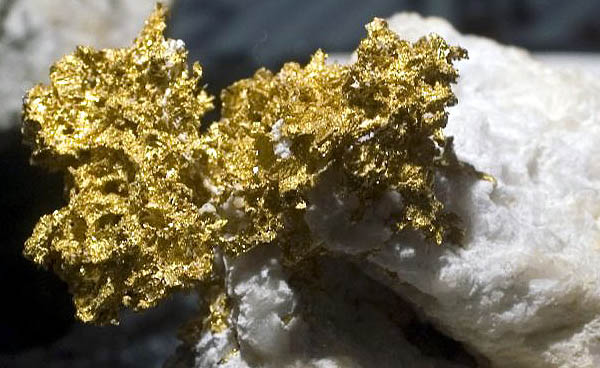
Gold. She lived "Hope", Brusson, Valle d'Aosta, North. Italy. Photo: © А.А. Evseev.

Gold (crystals up to 0.8 cm), quartz. Transylvania, Romania. Photo: © А.В. Sverdlov.
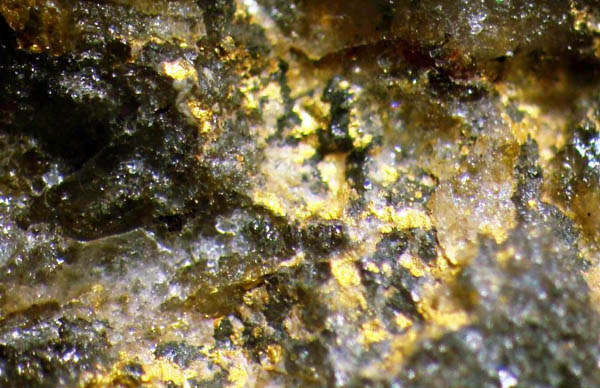
Gold in quartz pebbles from Bitak conglomerates. Simferopol, Crimea (Ukraine). Photo: © А.И. Tishchenko.
Gold yellow high silver is one of the first finds of native natural gold in the pebble quartz (smoky quartz moriones - in the photo, dark brown and honey-brown stone tones) from Bitak conglomerates - Simferopol (southern edge), outcrop of Bitak suite (lower - Middle Jurassic, Lower Toar - Lower Bayoss) in the vicinity. Dam of Simferopol reservoir, in pebbles of brownish quartz - visible xenomorphic yellow gold over fissures in quartz. Gold is associated with the dark-gray-gray telluride of bismuth (in the study stage) - the first discovery in the Crimea of tellurides (above).
Below is the first find in the Crimea of gold in association with chrysocolla (greenish-turquoise) - Opolnevskoe polymetallic manifestation (south-western Crimea, Hyr town west of the village of Blue Bay). Gold is observed in the oxidation zone in the form of xenomorphic grains of yellow color in a turquoise chrysocolla. Below is a scandalous (especially in recent years) gold of Russian gold mining, a nugget (the Urals, the Russian Federation, the CIS).
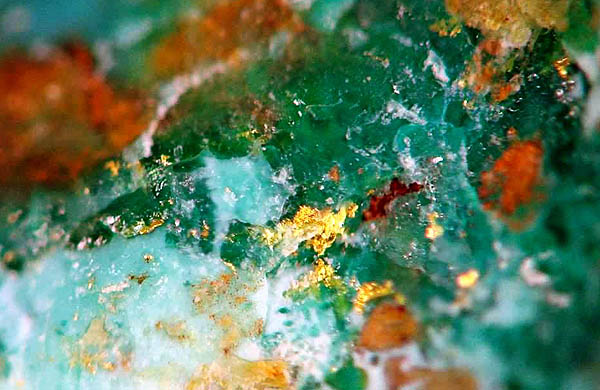
Gold in the chrysocolla. Opolnevskoe polymetallic manifestation, Khyr, Crimea (Ukraine, CIS). Photo: © А.И. Tishchenko.
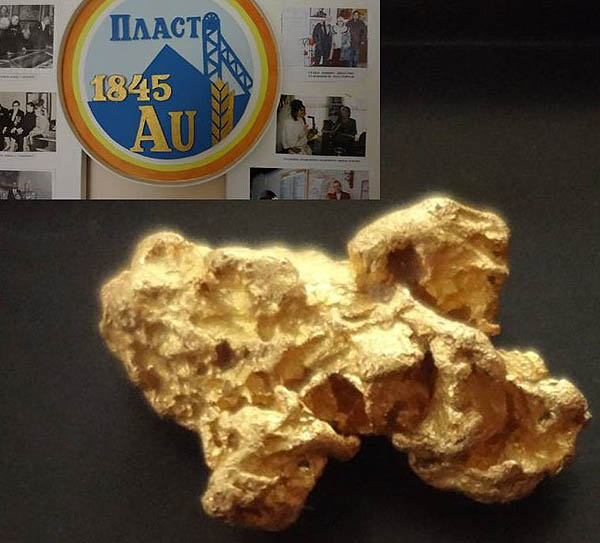
Gold (5.5 g). Yeleninskaya placer, Kamenka river, Ural, Russia, the CIS. Photo: © А.А. Evseev.
Gold enhances the bactericidal action of silver (destroys the shells of bacteria silver, gold destroys the mitochondria). Metal gold is not so toxic to the human body, unlike organic and other derivatives (toxic chloride of gold - in seawater, it stains water in turquoise green). In homeopathic (small) doses has anti-sclerotic effect. Perhaps the participation of gold in the normalization of immune processes in the body (treated for colds and ARVI - in the lagoons of the Pacific coast).
Gold is necessary: for polyarthritis, osteochondrosis, parodontosis, deforming arthritis, atherosclerosis, hypertension, liver diseases, depressive states. Preparations based on gold salts (sea salt halite, contains gold as a trace element) are used in the treatment of patients with rheumatoid and psoriatic arthritis, Felty syndrome, and lupus erythematosus. Gold preparations are administered both inside and parenterally, in the form of colloidal solutions (chrysoterapy). Gold can be involved in the processes of binding hormones in tissues.
The use of gold preparations is associated with a large number of side effects and contraindications (often fights of imaginary patients in hospitals and clinics - for gold bars and nuggets, "imaginary patient", from dentistry and orthodontics, dental crowns to oncology and chemotherapy, solutions, gilding). They bring it with black arsenic. They bring gold - and all of them "get sick" ("gold rush"), in the hospital appear imaginary gold prospectors - with metal detectors, it's not medicine (they rob you) !! Examples of gold from deposits ("wild").
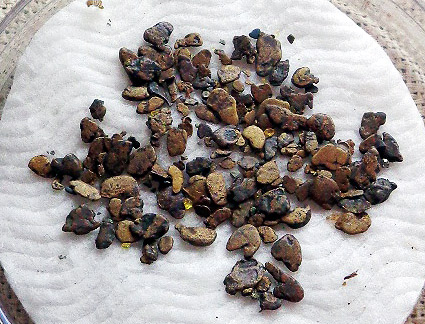
Gold. Plot Lonely, r. Kolyma, the Russian Federation (CIS). Sample: Geologist. The museum
them. A.A. Stukenberg, Kazan University (# 4862). Photo: © А.А. Evseev.
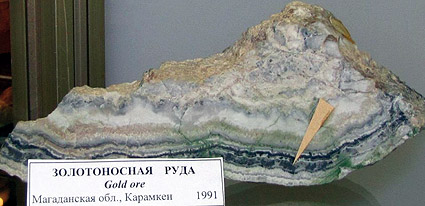
Gold-bearing ore. Karamken, Magadan Region, Russia (CIS). Photo: © А.А. Evseev.
Inclusions of native gold (golden). Do not have dental crowns.
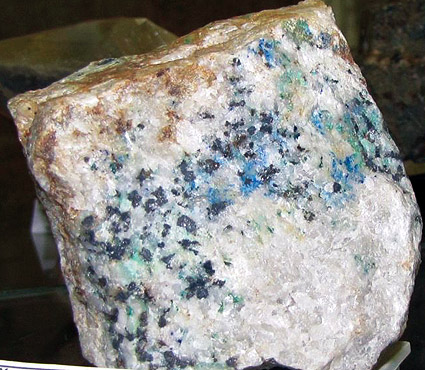
Freibergit in gold-bearing ore (gold - yellow).
School depository, Magadan region, Russia (CIS). Photo: © А.А. Evseev.
When poisoning: there are symptoms of CNS depression, pain along the nerves (neuritis, "pain nerve"); The appearance of painful spots on the skin; Increased sweating, pain in the bones, joints, muscles, swelling of the legs; conjunctivitis; Aplastic bone marrow hypoplasia; Pancytopenia (leukopenia, thrombocytopenia), weight loss. Radioactive gold (198Au) is used in the treatment of neoplastic diseases and, above all, lung cancer. Poisoning by gold is a rare phenomenon (seas and oceans, solonchaks, gold mines).
The mechanism of toxicity of gold ions is based on the affinity of this element for the sulfhydryl groups of proteins, as a result of which gold inhibits SH-enzymes. This mechanism is realized in the treatment of patients with rheumatoid arthritis, when the administration of gold preparations leads to a decrease in the activity of sulfhydryl systems and enzyme complexes of leukocytes, providing a reduction in the concentration of rheumatoid factor.
The waters of the ocean contain variable amounts of gold (from traces to 65 mg / ton) - poisoning by sea water is caused by poisoning with chemically-soluble gold ("Papuan's disease"). Food sources of gold: corn, leaves and stalks of corn (golden). The body contains about 10 mg of gold, half is concentrated in the bones. The distribution of gold depends on the solubility of its compounds. Colloidal compounds accumulate in the liver, soluble in the kidneys (kinovarization of the kidney).
Poisonous and radioactive dangerous stones and minerals
** - poisonous stones and minerals (mandatory check in the chemical laboratory + explicit indication of toxicity)
** - radioactive stones and minerals (mandatory check on the standard dosimeter + ban on open sales in case of radioactivity exceeding 24 milli / g / h + additional measures of population protection)
Catalog of minerals and semi-precious stones of the world by groups
** - poisonous stones and minerals
** - radioactive stones and minerals


Comments
Commenting on, remember that the content and tone of your message can hurt the feelings of real people, show respect and tolerance to your interlocutors even if you do not share their opinion, your behavior in the conditions of freedom of expression and anonymity provided by the Internet, changes Not only virtual, but also the real world. All comments are hidden from the index, spam is controlled.